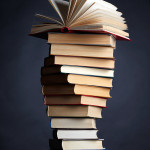Literary devices for the real world
Welcome back to my Tuesday blog on craft! Thanks to Aubrey for giving me the idea for my new series by suggesting I post on foreshadowing and flashbacks– when to use them, when to avoid them, etc. I thought I’d use that as a jumping off point for a longer series on recognizing literary devices in your writing and using them effectively, and if that sounds like a nightmare flashback to high school English, that was intentional– hear me out before you click back over to Facebook.
We all took the same high school and college English classes in which we pointed out allegory and symbolism and foreshadowing in the same twelve pieces of literature, hand-picked because they provided the most blatantly recognizable examples of those symbols. Out in the real world, however, in the absence of the flashing neon lights of the textbook’s prompts and the teacher’s hints, we don’t always recognize those literary devices when they show up in our writing, and so we miss the opportunity to really develop them/use them most effectively. As an agent, I see writing all the time that is “almost there–” if the author just dug a little deeper in the characterizations, if he just developed the point of view a little more clearly, if she just found a little more consistency in tone, this manuscript would be great! But when I give that feedback to these same authors, too often their response is the email equivalent of a blank look– “How would I describe my tone? Um… sad, I guess? Or maybe dark. But it’s funny in places– can a tone be funny and sad? Do you mean tone as in, ‘leave a message after the?'” And so on. Without a clear understanding of tone and what determines it, an author is pretty powerless to evaluate it in his work and to strengthen/improve it if needed, and the same goes for many other qualities of story and writing.
It will be important as this series continues that I clarify that not all the literary devices we’ll talk about have a place in every manuscript. Your suspense novel doesn’t have to be allegorical. Your chick-lit romantic comedy doesn’t need to be riddled with symbolism (thought that’s not to say it can’t be, I suppose…). Whatever kind of writer you are, thinking about these various storytelling devices and writing tools and how they affect the reader’s experience of your story only makes you a stronger, more artful writer. A classroom knowledge of literary devices lets you analyze literature, the ability to apply that knowledge to your writing lets you write literature (or at least write a more engaging, better-written novel). So dig out your Trapper Keeper, sharpen your pencils, and adjust your headgear (or maybe that was just my high school experience…) and come back in the weeks to come as we take a look at literary devices for the real world.
Next week, I’ll kick off the series by talking about flashbacks and foreshadowing, so if you have any specific questions about either of those, or if you have a suggestion for an entry in this series, let me know in the comments. As always, thanks for reading!



7 Comments
Erin, I’m interested in knowing how to handle flashbacks. I know “too much” is death to a novel, but when and where do you cross that line?
Sounds like fun..bring it on!
Ooh, I’m sharpening my metaphorical pencil now. If only I could find my old Trapper Keeper! Can’t wait for next week.
I definitely enjoy your class, Erin.
I look forward to this upcoming series with great anticipation. While I feel I fully understand my author’s voice and my skills as a storyteller, I am ALWAYS open to learning more about the craft of writing well because I’m always aspiring to be stronger than I currently am…;~)
Thanks for all you do for the writing community!
I have always struggled with understanding symbolism. I understand the technique, but struggle to recognize a symbol and what it stands for. E.g. snakes are often symbolic, but symbolic of what? And from culture to culture symbols can be understood differently, but there are also universal symbols such a bread, and water. As a writer and a reader, if I don’t know what things symbolize, how can I use them in my story and how can I recognize them in someone else’s?
An interesting article, Erin. In my first novel Peeling Oranges, there are multiple symbols of orange. http://www.jameslawless.net